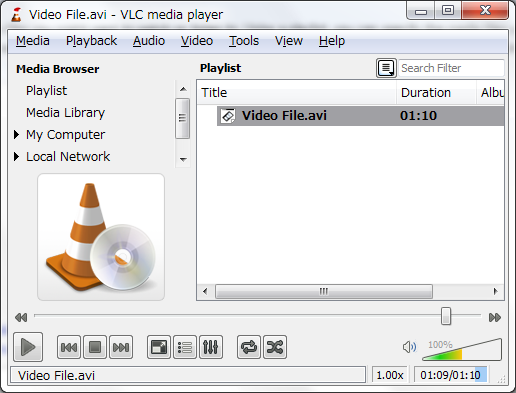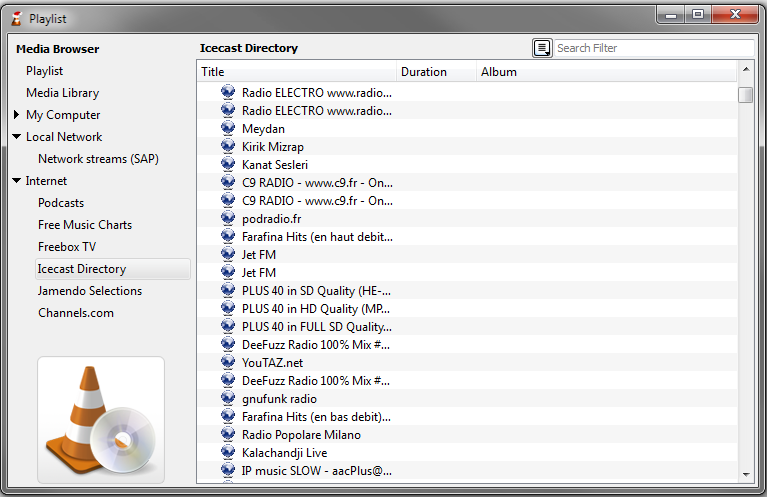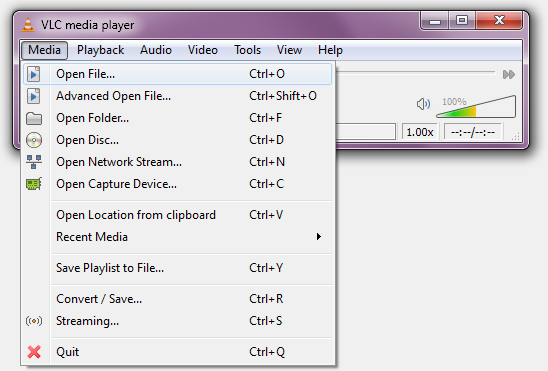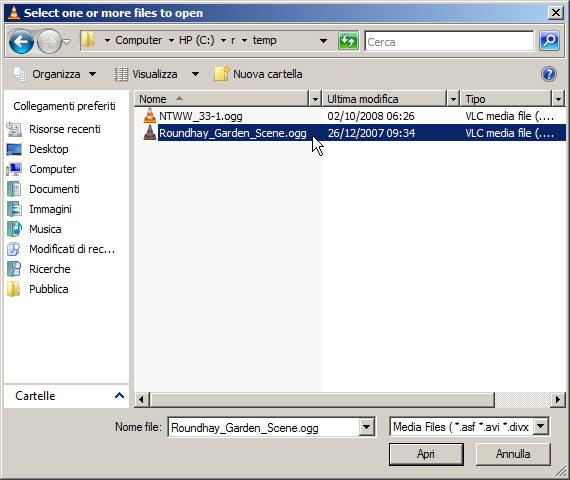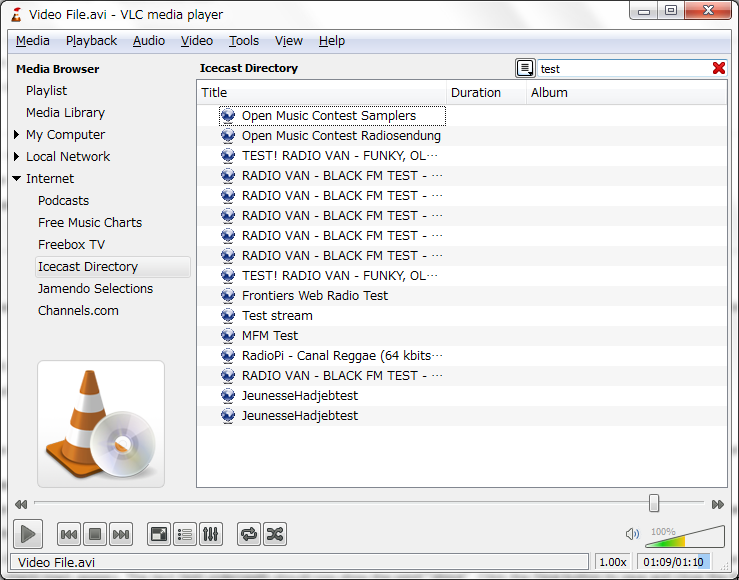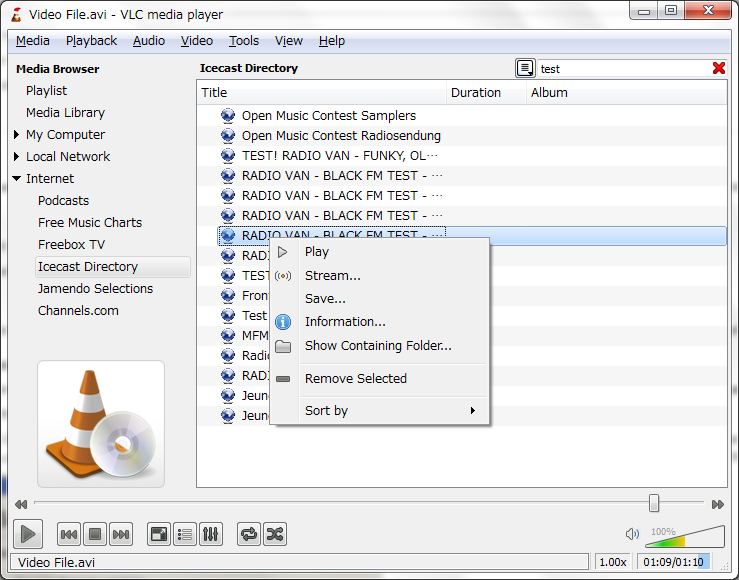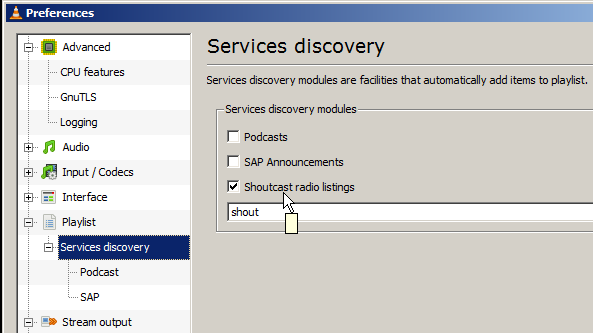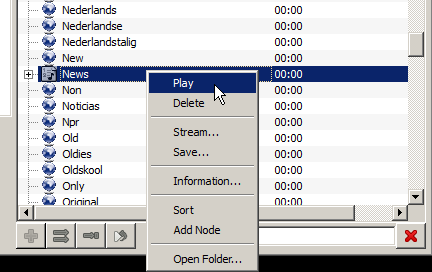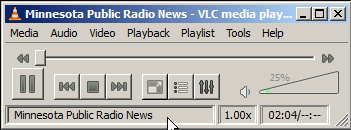Difference between revisions of "Documentation:Playlist"
Smu33rules (talk | contribs) |
m (+Category:Playlist) |
||
| (40 intermediate revisions by 8 users not shown) | |||
| Line 1: | Line 1: | ||
| − | {{RightMenu| | + | {{RightMenu|Documentation TOC}} |
| + | A playlist is a customised list of media files you might want to watch or listen to. Using a playlist, you can specify the media files you want to listen each time you start the VLC media player. You can add tracks from CDs, radio stations, and movies to a playlist. To access the playlist, click on the ''Playlist'' button in the main interface. | ||
| − | == Additional Sources == | + | [[File:Basic_playlist_default.png]] |
| + | |||
| + | The default playlist view. | ||
| + | |||
| + | == Additional Sources == | ||
In addition to audio and video files, you can play other formats. The additional formats supported by VLC media player are described in the following sections: | In addition to audio and video files, you can play other formats. The additional formats supported by VLC media player are described in the following sections: | ||
*'''Podcasts''' - Podcast (Personal On Demand broadCASTING) is a series of audio or video digital media files which is distributed over the Internet and downloaded to media players. If consumers subscribe to Podcasts, whenever new content is added the content gets automatically added to the playlist. You can customise Podcasts. To add a Podcast URL | *'''Podcasts''' - Podcast (Personal On Demand broadCASTING) is a series of audio or video digital media files which is distributed over the Internet and downloaded to media players. If consumers subscribe to Podcasts, whenever new content is added the content gets automatically added to the playlist. You can customise Podcasts. To add a Podcast URL | ||
| − | + | #Select the [[File:VLC - playlist.png]] ''Playlist'' button. | |
| − | + | #Click on the ''Internet'' button to select it in the left pane. The ''Podcasts'' menu item will appear under ''Internet''. | |
| − | + | #Select a Podcast stream in the main dialog box. Then right-click the stream and select ''Play'' from the popup menu. | |
| − | + | *'''SAP Announcements''' – Helps to advertise your stream over the network. | |
| − | *'''SAP Announcements''' – Helps to advertise your stream over the network. | + | |
| − | To play a SAP announcement | + | To play a SAP announcement: |
| − | #Select | + | #Select the [[File:VLC - playlist.png]] ''Playlist'' button. |
| − | + | #Click on the ''Local Area Network'' to select it in the left pane. The ''Network Streams (SAP)'' menu item will appear under ''Local Area Network''. | |
| − | #Click on '' | + | #Select an SAP announcement and right-click. Select ''Play'' from the popup menu. |
| − | #Select an SAP announcement and right-click. Select | ||
| − | |||
| − | |||
| − | + | *'''Shoutcast Radio Listings''' – Shoutcast is a server for streaming the media developed by Nullsoft. Digital audio content can be broadcast from and to media players, and this helps individuals to create Internet radio networks. Using VLC media player, you can listen to your favourite radio stations and you can also create bookmarks to listen to these radio stations in future. | |
| − | |||
| − | |||
| − | |||
| − | + | To customize a Shoutcast radio listing: | |
| − | |||
| − | |||
| − | |||
| − | |||
| − | |||
| − | |||
| − | |||
| − | |||
| − | |||
| − | |||
| − | |||
| − | |||
| − | ''' | + | #Select the [[File:VLC - playlist.png]] ''Playlist'' button. |
| + | #Select ''Icecast Directory'' under ''Internet'' in the ''Playlist'' menu. A list of radio stations appears in the right hand panel. If nothing appears in the right hand panel try double-clicking the ''Shoutcast Radio'' option and wait. It may take a few minutes the first time. After a while, the right hand panel displays a list of titles. | ||
| − | == Add Media Files to Playlist == | + | [[File:Shoutcastdirectory.PNG]] |
| + | |||
| + | #Scroll down and select a radio station. | ||
| + | #Right-click on a radio station and: | ||
| + | ##Select ''Play'' if you want to listen to the radio station. | ||
| + | ##Select ''Remove Selected'' if you want to delete the radio station. | ||
| + | ##Select the ''Stream'' option. The Stream output dialog box is displayed. Refer to the Specifying [[#Specifying_Streaming_Options|Specifying Streaming options]] section for more details. Modify the required parameters and click on the ''Stream'' button to stream the media file. | ||
| + | ##Click to select a title in the Playlist dialog box and right-click. Select ''Save'' from the popup menu. The Stream Output dialog box is displayed. Select the required options and click on the ''Save'' button in the Stream Output dialog box. Refer to the [[#Specifying_Streaming_Options|Specifying Streaming options]] section for more details. | ||
| + | ##Select the Information option. The Media Information dialog box is displayed with details of the media being played. | ||
| + | ##Select ''Title'' to alphabetically sort the radio stations. | ||
| + | ##Click to select a title in the Playlist dialog box and right-click. Select ''Open Folder'' from the popup menu. A folder is opened to show all sub nodes within a title. | ||
| + | ##Select ''Add Node'' to add a node. | ||
| + | ##Click to select a title in the Playlist dialog box and right-click. Select ''Information'' from the popup menu to view the details of the selected title. Refer to the ''Media Information'' section for more details on options. | ||
| + | |||
| + | *''Shoutcast TV stream'' – You can watch streaming TV using the VLC media player. Shoutcast TV stream refers to a stream transmitted by Nullsoft. The procedure of customising the TV stream and the options are similar to that of the Shoutcast Radio. | ||
| + | *''Freebox TV listing'' – Refers to television service over ADSL accessible by Freebox Free Zone unbundled. | ||
| + | |||
| + | ''Note:'' You should be connected to the Internet to access these streams. | ||
| + | |||
| + | == Add Media Files to Playlist == | ||
You can add several media files to a playlist. The media files could be selected from the media library, additional sources, and some other source. | You can add several media files to a playlist. The media files could be selected from the media library, additional sources, and some other source. | ||
| − | To add files to a playlist | + | To add files to a playlist: |
| − | #Select | + | #Select the [[File:VLC - playlist.png]] ''Playlist'' button. |
| − | # | + | #Right-click on the dialog box and click and a short list appears with two options: Add file and Add directory. |
| − | + | ##Select ''Add file'' to add a file to the playlist. | |
| − | ##Select | + | ##Select ''Add directory'' to add a directory containing media files to the playlist. |
| − | ##Select | + | #Click on the [[File:Random.JPG]] '''Random''' icon. This icon toggles between ''Random'' and ''Random Off''. Click on [[File:Random.JPG]] to play files at random. Click on [[File:Random.JPG]] and the files are played in an order. |
| − | #Click on the [[ | + | #Click on the [[File:Repeat.JPG]] ''Repeat'' icon. This icon toggles between ''Repeat One'' and ''Repeat All''. If you want to listen to a track several times, click on [[File:Repeat.JPG]] icon. If you want to listen to all tracks, click on [[File:Repeat.JPG]] again. |
| − | #Click on the [[ | + | #To search for a media file, enter the name in the ''Search'' box. To search for media files with certain names or formats, enter a word or phrase in the ''Search'' box. All files with the specified name are listed. |
| − | #To search for a media file, enter the name in the | + | #Click on the [[File:Skip.JPG]] icon. This icon is used to skip to the current item when you have a very long list. |
| − | #Click on the [[ | + | #Click the ''Remove Selected'' button to clear a track from the playlist. |
| − | #Click | ||
| − | == Load Playlist == | + | == Load Playlist == |
| − | This option is used to add a playlist created in some other media player. You can load playlists of the ''.xspf, .asx, .b4s'' and ''.m3u'' formats. To load a playlist | + | This option is used to add a playlist created in some other media player. You can load playlists of the ''.xspf, .asx, .b4s'' and ''.m3u'' formats. To load a playlist: |
| + | |||
| + | #Select the ''Open'' option from the ''Media'' menu. The ''Open file'' dialog box is displayed. | ||
| + | #In the bottom right, change the format to ''Playlist Files'' in the selector. | ||
| + | #Locate a playlist file and click on ''Open''. | ||
| − | |||
| − | |||
The selected playlist is added in the current playlist dialog box. | The selected playlist is added in the current playlist dialog box. | ||
| + | <br> | ||
| − | == Save Playlist == | + | == Save Playlist == |
| − | You can save playlists using the VLC media player in format of your choice. To save a playlist | + | You can save playlists using the VLC media player in format of your choice. To save a playlist: |
#Create a playlist. Refer to [[#Add_Media_Files_to_Playlist|Add Media Files to Playlist]] for creating a playlist. | #Create a playlist. Refer to [[#Add_Media_Files_to_Playlist|Add Media Files to Playlist]] for creating a playlist. | ||
| − | #Select | + | #Select ''Save Playlist to File'' from the ''Media'' menu. The ''Choose a filename to save playlist'' dialog box is displayed. |
| − | #Select the | + | #Select a name for the playlist. |
| − | #Select a format in which the playlist must be saved from the | + | #Select a format in which the playlist must be saved from the ''Files of type'' list. The Files of type list contains the ''.xspf'' and ''.m3u'' formats. |
| − | #Click on | + | #Click on ''Save'' to save the playlist in the selected format. |
| + | |||
| + | == Play a file == | ||
| + | |||
| + | To play a file, open the Media menu, and select the Open File menu item. An Open File dialog box will appear. Select the file you want to open, and click Open. VLC will start playing the selected file. An alternative is to drag 'and' drop your file onto the VLC main interface or playlist window from the file explorer (Finder on MacOS X). | ||
| − | + | [[File:VLC - open file.png]] | |
| − | |||
VLC 0.9.8a version Windows XP mode | VLC 0.9.8a version Windows XP mode | ||
| − | |||
| − | + | https://images.videolan.org/images/documentation/play-howto/intf-osx-file-menu.jpg | |
| − | |||
| − | + | The File menu - MacOS X interface'''- needs verifying for 0.9''' | |
| − | |||
| − | + | [[File:Vlc-mediaopenfileselected-vistaclassic-en.png]] | |
| − | |||
| − | + | The Open file dialog - wxWidgets interface | |
| − | + | (FIXME need 0.9 screenshot for MacOS) The Open file dialog - MacOS X interface | |
| − | + | == Naming Files == | |
| − | + | You can change the original file name to one you would like before adding the file to VLC. When adding files from the menu bar, the new file name will show in the playlist. However, when dropping the file using the "add/drop" option, VLC may not recognize the name change depending on the file type. In that case, you can right click the header of the playlist column and select "URL," you will then see the original file path for the file. | |
| − | == Sorting == | + | == Sorting == |
In the wxWidgets interface, ''Sort'' allows you to sort the playlist according to several criteria, or to shuffle it. You can also sort by clicking the header of the column. | In the wxWidgets interface, ''Sort'' allows you to sort the playlist according to several criteria, or to shuffle it. You can also sort by clicking the header of the column. | ||
| Line 111: | Line 119: | ||
In the MacOS X interface, sorting can be done by clicking the header of the column matching the criteria you want to use for sorting. | In the MacOS X interface, sorting can be done by clicking the header of the column matching the criteria you want to use for sorting. | ||
| − | == Playlist modes == | + | == Playlist modes == |
The playlist supports several playback modes. | The playlist supports several playback modes. | ||
| − | In the wxWidgets interface, the toolbar contains three playlist mode buttons. They allow to enable random mode, to repeat the whole playlist or to repeat one item. | + | In the wxWidgets interface, the toolbar contains three playlist mode buttons. They allow you to enable random mode, to repeat the whole playlist or to repeat one item. |
In the MacOS X interface, random mode can be enabled by selecting the ''Random'' box. A drop down menu allows you to enable playlist and item repeat modes. | In the MacOS X interface, random mode can be enabled by selecting the ''Random'' box. A drop down menu allows you to enable playlist and item repeat modes. | ||
| − | == Misc == | + | == Misc == |
| + | |||
| + | === Search === | ||
| − | + | You also have a search tool. Enter a search string and hit search. The next item to match the string will be highlighted. Keep hitting Search to cycle between all matching items. | |
| − | + | [[File:Basic_playlist_search.png]] | |
| − | === Moving items === | + | === Moving items === |
In the wxWidgets interface, the ''Up'' and ''Down'' buttons at the bottom of the playlist window allow you to move an item. Select an item and use these buttons to move it. | In the wxWidgets interface, the ''Up'' and ''Down'' buttons at the bottom of the playlist window allow you to move an item. Select an item and use these buttons to move it. | ||
| Line 131: | Line 141: | ||
In the MacOS X interface, you can easily move an item with the mouse, using drag-and-drop. | In the MacOS X interface, you can easily move an item with the mouse, using drag-and-drop. | ||
| − | === Contextual menu === | + | === Contextual menu === |
| − | By right-clicking or control-clicking an item, a contextual menu will appear, giving access to a number of functions (for example, play the item, disable it, delete it, or get info on it). | + | By right-clicking or control-clicking an item, a contextual menu will appear, giving access to a number of functions (for example, play the item, disable it, delete it, or get info on it). |
| − | + | [[File:Basic_playlist_contextual.png]] | |
| − | |||
| − | |||
| − | |||
| − | |||
| − | |||
| − | |||
| − | |||
| − | |||
| − | |||
| − | |||
| − | |||
| − | |||
| − | |||
| − | |||
| − | |||
=== Example finding a Shoutcast radio stream === | === Example finding a Shoutcast radio stream === | ||
| Line 160: | Line 155: | ||
2. Click ''Tools'' then ''Preferences'', click Interface and then click All under "Show settings". Then click the "-" next to "Playlist" in order to show the "Services discovery" submenu. If the shoutcast radio listings box is empty, click it so that a check-mark appears. The text field underneath should now show the word "shout". Click the Save button to save and close the Preferences window: | 2. Click ''Tools'' then ''Preferences'', click Interface and then click All under "Show settings". Then click the "-" next to "Playlist" in order to show the "Services discovery" submenu. If the shoutcast radio listings box is empty, click it so that a check-mark appears. The text field underneath should now show the word "shout". Click the Save button to save and close the Preferences window: | ||
| − | [[ | + | [[File:Vlc-preferencesservicesdiscoveryshoutcrop-en.png]] |
3. Restart VLC media player to make it take notice of the changed preferences. | 3. Restart VLC media player to make it take notice of the changed preferences. | ||
| Line 166: | Line 161: | ||
4. On the VLC interface click ''Playlist'', then click ''Show Playlist''. Select the "Shoutcast Radio" in the left hand panel. If nothing appears in the righthand panel, try double-clicking "Shoutcast Radio" and waiting, it may take a few minutes the first time. After a while the righthand panel displays a long list of titles. | 4. On the VLC interface click ''Playlist'', then click ''Show Playlist''. Select the "Shoutcast Radio" in the left hand panel. If nothing appears in the righthand panel, try double-clicking "Shoutcast Radio" and waiting, it may take a few minutes the first time. After a while the righthand panel displays a long list of titles. | ||
| − | [[ | + | [[File:Vlc-playlistshoutcastradio-en.png]] |
5. Scroll down the radio stations in the right-hand panel and select one. Click the mouse right button and click the "Play" item. | 5. Scroll down the radio stations in the right-hand panel and select one. Click the mouse right button and click the "Play" item. | ||
| − | [[ | + | [[File:Vlc-playlistshoutcastradioplay-en.png]] |
6. It may take some time for the connection to the radio station to establish (and it may fail if the station's outgoing streams are all occupied). When it does connect, VLC should start playing the audio stream from the station: | 6. It may take some time for the connection to the radio station to establish (and it may fail if the station's outgoing streams are all occupied). When it does connect, VLC should start playing the audio stream from the station: | ||
| − | [[ | + | [[File:Vlc-playlistshoutcastradioplayingsmall-en.png]] |
=== Example playing a known Shoutcast radio stream === | === Example playing a known Shoutcast radio stream === | ||
| Line 184: | Line 179: | ||
For example, to find a BBC World Service radio stream, use a browser to go to: http://www.shoutcast.com/directory/search_results.jsp?searchCrit=simple&s=bbc | For example, to find a BBC World Service radio stream, use a browser to go to: http://www.shoutcast.com/directory/search_results.jsp?searchCrit=simple&s=bbc | ||
| − | One of the stations listed may be playing the World Service, if so move your mouse over the "TUNEIN!" webicon and click the right mouse button and click "Save Link As...", as described above | + | One of the stations listed may be playing the World Service, if so move your mouse over the "TUNEIN!" webicon and click the right mouse button and click "Save Link As...", as described above. |
| − | |||
| − | |||
| − | |||
| − | |||
| − | |||
| − | |||
| − | |||
| − | |||
| − | |||
| − | |||
| − | |||
| − | |||
| − | |||
| − | |||
| − | |||
| − | |||
| − | + | {{Documentation}} | |
| − | + | [[Category:Playlist|*]] | |
Latest revision as of 07:51, 11 February 2019
A playlist is a customised list of media files you might want to watch or listen to. Using a playlist, you can specify the media files you want to listen each time you start the VLC media player. You can add tracks from CDs, radio stations, and movies to a playlist. To access the playlist, click on the Playlist button in the main interface.
The default playlist view.
Contents
Additional Sources
In addition to audio and video files, you can play other formats. The additional formats supported by VLC media player are described in the following sections:
- Podcasts - Podcast (Personal On Demand broadCASTING) is a series of audio or video digital media files which is distributed over the Internet and downloaded to media players. If consumers subscribe to Podcasts, whenever new content is added the content gets automatically added to the playlist. You can customise Podcasts. To add a Podcast URL
- Select the
 Playlist button.
Playlist button. - Click on the Internet button to select it in the left pane. The Podcasts menu item will appear under Internet.
- Select a Podcast stream in the main dialog box. Then right-click the stream and select Play from the popup menu.
- SAP Announcements – Helps to advertise your stream over the network.
To play a SAP announcement:
- Select the
 Playlist button.
Playlist button. - Click on the Local Area Network to select it in the left pane. The Network Streams (SAP) menu item will appear under Local Area Network.
- Select an SAP announcement and right-click. Select Play from the popup menu.
- Shoutcast Radio Listings – Shoutcast is a server for streaming the media developed by Nullsoft. Digital audio content can be broadcast from and to media players, and this helps individuals to create Internet radio networks. Using VLC media player, you can listen to your favourite radio stations and you can also create bookmarks to listen to these radio stations in future.
To customize a Shoutcast radio listing:
- Select the
 Playlist button.
Playlist button. - Select Icecast Directory under Internet in the Playlist menu. A list of radio stations appears in the right hand panel. If nothing appears in the right hand panel try double-clicking the Shoutcast Radio option and wait. It may take a few minutes the first time. After a while, the right hand panel displays a list of titles.
- Scroll down and select a radio station.
- Right-click on a radio station and:
- Select Play if you want to listen to the radio station.
- Select Remove Selected if you want to delete the radio station.
- Select the Stream option. The Stream output dialog box is displayed. Refer to the Specifying Specifying Streaming options section for more details. Modify the required parameters and click on the Stream button to stream the media file.
- Click to select a title in the Playlist dialog box and right-click. Select Save from the popup menu. The Stream Output dialog box is displayed. Select the required options and click on the Save button in the Stream Output dialog box. Refer to the Specifying Streaming options section for more details.
- Select the Information option. The Media Information dialog box is displayed with details of the media being played.
- Select Title to alphabetically sort the radio stations.
- Click to select a title in the Playlist dialog box and right-click. Select Open Folder from the popup menu. A folder is opened to show all sub nodes within a title.
- Select Add Node to add a node.
- Click to select a title in the Playlist dialog box and right-click. Select Information from the popup menu to view the details of the selected title. Refer to the Media Information section for more details on options.
- Shoutcast TV stream – You can watch streaming TV using the VLC media player. Shoutcast TV stream refers to a stream transmitted by Nullsoft. The procedure of customising the TV stream and the options are similar to that of the Shoutcast Radio.
- Freebox TV listing – Refers to television service over ADSL accessible by Freebox Free Zone unbundled.
Note: You should be connected to the Internet to access these streams.
Add Media Files to Playlist
You can add several media files to a playlist. The media files could be selected from the media library, additional sources, and some other source.
To add files to a playlist:
- Select the
 Playlist button.
Playlist button. - Right-click on the dialog box and click and a short list appears with two options: Add file and Add directory.
- Select Add file to add a file to the playlist.
- Select Add directory to add a directory containing media files to the playlist.
- Click on the
Random icon. This icon toggles between Random and Random Off. Click on
to play files at random. Click on
and the files are played in an order.
- Click on the
Repeat icon. This icon toggles between Repeat One and Repeat All. If you want to listen to a track several times, click on
icon. If you want to listen to all tracks, click on
again.
- To search for a media file, enter the name in the Search box. To search for media files with certain names or formats, enter a word or phrase in the Search box. All files with the specified name are listed.
- Click on the
icon. This icon is used to skip to the current item when you have a very long list.
- Click the Remove Selected button to clear a track from the playlist.
Load Playlist
This option is used to add a playlist created in some other media player. You can load playlists of the .xspf, .asx, .b4s and .m3u formats. To load a playlist:
- Select the Open option from the Media menu. The Open file dialog box is displayed.
- In the bottom right, change the format to Playlist Files in the selector.
- Locate a playlist file and click on Open.
The selected playlist is added in the current playlist dialog box.
Save Playlist
You can save playlists using the VLC media player in format of your choice. To save a playlist:
- Create a playlist. Refer to Add Media Files to Playlist for creating a playlist.
- Select Save Playlist to File from the Media menu. The Choose a filename to save playlist dialog box is displayed.
- Select a name for the playlist.
- Select a format in which the playlist must be saved from the Files of type list. The Files of type list contains the .xspf and .m3u formats.
- Click on Save to save the playlist in the selected format.
Play a file
To play a file, open the Media menu, and select the Open File menu item. An Open File dialog box will appear. Select the file you want to open, and click Open. VLC will start playing the selected file. An alternative is to drag 'and' drop your file onto the VLC main interface or playlist window from the file explorer (Finder on MacOS X).
VLC 0.9.8a version Windows XP mode

The File menu - MacOS X interface- needs verifying for 0.9
The Open file dialog - wxWidgets interface
(FIXME need 0.9 screenshot for MacOS) The Open file dialog - MacOS X interface
Naming Files
You can change the original file name to one you would like before adding the file to VLC. When adding files from the menu bar, the new file name will show in the playlist. However, when dropping the file using the "add/drop" option, VLC may not recognize the name change depending on the file type. In that case, you can right click the header of the playlist column and select "URL," you will then see the original file path for the file.
Sorting
In the wxWidgets interface, Sort allows you to sort the playlist according to several criteria, or to shuffle it. You can also sort by clicking the header of the column.
In the MacOS X interface, sorting can be done by clicking the header of the column matching the criteria you want to use for sorting.
Playlist modes
The playlist supports several playback modes.
In the wxWidgets interface, the toolbar contains three playlist mode buttons. They allow you to enable random mode, to repeat the whole playlist or to repeat one item.
In the MacOS X interface, random mode can be enabled by selecting the Random box. A drop down menu allows you to enable playlist and item repeat modes.
Misc
Search
You also have a search tool. Enter a search string and hit search. The next item to match the string will be highlighted. Keep hitting Search to cycle between all matching items.
Moving items
In the wxWidgets interface, the Up and Down buttons at the bottom of the playlist window allow you to move an item. Select an item and use these buttons to move it.
In the MacOS X interface, you can easily move an item with the mouse, using drag-and-drop.
By right-clicking or control-clicking an item, a contextual menu will appear, giving access to a number of functions (for example, play the item, disable it, delete it, or get info on it).
Example finding a Shoutcast radio stream
This example was verified as working on 15 October 2008, using VLC 0.9.4 under Windows Vista. This needs reproducing by other people on other versions and other operating systems.
1. Ensure your firewall is set to allow the VideoLan program to make outgoing connections.
2. Click Tools then Preferences, click Interface and then click All under "Show settings". Then click the "-" next to "Playlist" in order to show the "Services discovery" submenu. If the shoutcast radio listings box is empty, click it so that a check-mark appears. The text field underneath should now show the word "shout". Click the Save button to save and close the Preferences window:
3. Restart VLC media player to make it take notice of the changed preferences.
4. On the VLC interface click Playlist, then click Show Playlist. Select the "Shoutcast Radio" in the left hand panel. If nothing appears in the righthand panel, try double-clicking "Shoutcast Radio" and waiting, it may take a few minutes the first time. After a while the righthand panel displays a long list of titles.
5. Scroll down the radio stations in the right-hand panel and select one. Click the mouse right button and click the "Play" item.
6. It may take some time for the connection to the radio station to establish (and it may fail if the station's outgoing streams are all occupied). When it does connect, VLC should start playing the audio stream from the station:
Example playing a known Shoutcast radio stream
Go to http://www.shoutcast.com/ and search for a radio station of your choice. On Windows, right-click your mouse over Shoutcast's "Tunein" button and click "Save Link As..." to save the playlist on your computer. Remember where you saved the playlist, rename it to something that makes sense.
At any time later, you can use VLC to open the saved playlist and listen to that radio station.
For example, to find a BBC World Service radio stream, use a browser to go to: http://www.shoutcast.com/directory/search_results.jsp?searchCrit=simple&s=bbc
One of the stations listed may be playing the World Service, if so move your mouse over the "TUNEIN!" webicon and click the right mouse button and click "Save Link As...", as described above.
Please read the Documentation Editing Guidelines before you edit the documentation
